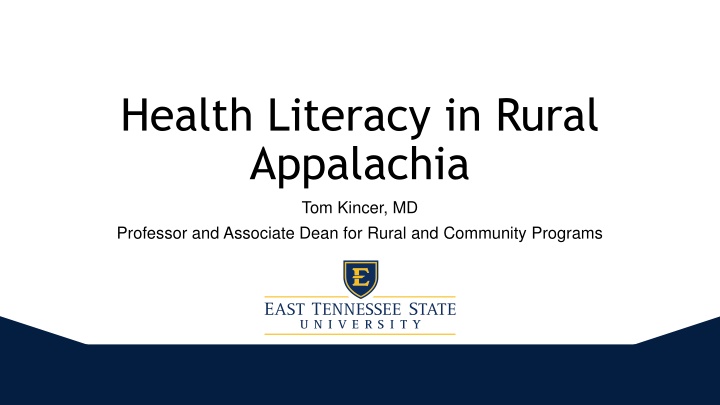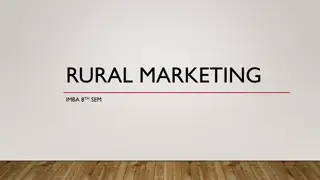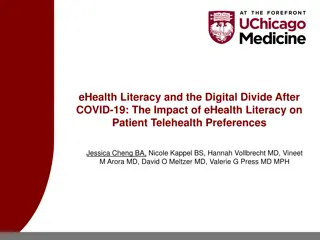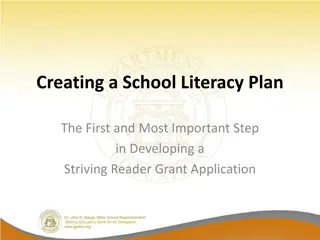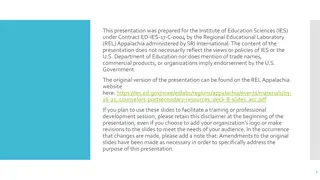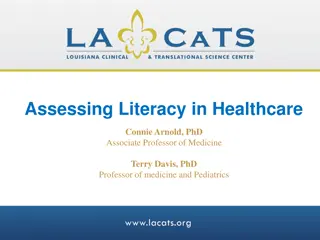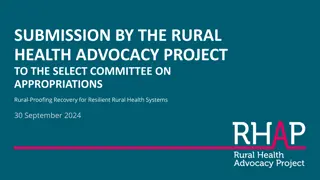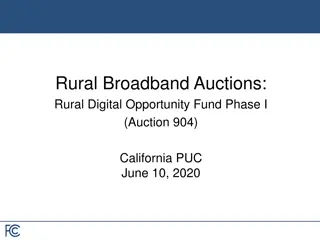Health Literacy in Rural Appalachia: Understanding the Impact and Needs
Health literacy is crucial in rural Appalachia where low literacy levels contribute to poor health outcomes. Understanding, supporting, and improving health literacy among the population can lead to better health decisions and reduced disparities in healthcare access and outcomes. This article explores the definition of health literacy, its importance in rural communities, and the challenges faced in improving health literacy to address the region's health disparities.
Download Presentation

Please find below an Image/Link to download the presentation.
The content on the website is provided AS IS for your information and personal use only. It may not be sold, licensed, or shared on other websites without obtaining consent from the author.If you encounter any issues during the download, it is possible that the publisher has removed the file from their server.
You are allowed to download the files provided on this website for personal or commercial use, subject to the condition that they are used lawfully. All files are the property of their respective owners.
The content on the website is provided AS IS for your information and personal use only. It may not be sold, licensed, or shared on other websites without obtaining consent from the author.
E N D
Presentation Transcript
Health Literacy in Rural Appalachia Tom Kincer, MD Professor and Associate Dean for Rural and Community Programs
Disclosures Nothing to disclose
Objectives To define health literacy To examine the health literacy in rural Appalachia To show the impact of low literacy on disease states
Define Health Literacy Initially, health literacy referred to an individual s ability to understand healthcare information to make appropriate decisions (S. C Ratzen & R. M. Parker, 2000). However, the definition has expanded and for the Healthy People 2010 initiative, health literacy was defined as the degree to which individuals have the capacity to obtain, process, and understand basic health information and services needed to make appropriate health decisions (Ratzen & Parker, 2000).
Health Literacy versus Health Knowledge Literacy may be thought of as the ability to obtain, process, and understand. Whereas, knowledge can be thought of as knowing facts and data. Believing and knowing are different (see next slide) Given this, one can be literate but not knowledgeable But, it s difficult to be illiterate yet knowledgeable
Supporting Patient Needs From this definition, healthcare providers can see that they need to support the health literacy of patients by providing health information in a manner that promotes comprehension and supports healthcare decision making. By understanding the health literacy abilities of the Appalachian population, nurses and other healthcare professionals can better develop education that supports comprehension and appropriate healthcare decision making.
What We Know Appalachian people are less healthy than other parts of the country. Appalachian people are twice a likely to be uninsured. Every mortality indicator is higher in the region than in the nation overall: heart disease is 17 percent higher; cancer is 10 percent higher; COPD is 27 percent higher; injury is 33 percent higher; stroke is 14 percent higher; and diabetes is 11 percent higher. Years of Potential Life Lost is 40% higher in distressed regions of Appalachia than other parts of the country.
But Why? Access to Healthcare Higher rates of smoking: 25% vs 16% Lower rates of education: 58% H.S. graduation rate in distressed Appalachia Lower income: 20% poverty rate vs 11% Culture Health literacy
Culture Appalachian people, especially the rural population, tend to approach their family members and religious leaders first with personal, family, or health problems. Because of the years of external exploitation and stereotyping, Appalachians are slow to tell outsiders about family business. Due to the high rates of trauma and exposure to adverse events through the life cycle, many people consider these events part of life, but still exhibit symptoms of trauma-related disorders. This culture values down to earth more than expert opinion .
Components of Health Literacy Education levels Cultural beliefs Prose, Document, Quantitative literacy Availability of Health Care Availability to receive health care Language Poverty
Literacy Levels Below basic literacy level is described as no more than the most simple and concrete literacy skills Basic literacy level refers to skills necessary to perform simple and everyday literacy activities Intermediate literacy level encompasses skills necessary to perform moderately challenging literacy activities Proficient literacy refers to skills necessary to perform more complex and challenging literacy activities
National Distribution 14% had below basic health literacy. 22% had basic health literacy 53% had an intermediate level of health literacy. 12% scored in the proficient range. Overall, 36% of the adult participants had basic or below basic health literacy skills. This represents more than one third of the population (Kutner et al., 2006).
Identifying Literacy Levels Assume lower than average literacy levels until proven otherwise. Be aware of red flags Medications not being used correctly Unable to use basic medical terms Not following advice Ask respectfully Have them repeat explanations/instructions back to you
General Approach Ask patients if they need help filling out forms or working a Kiosk. Ask patients if they have internet at home and how they use it. Ask all patients if they have trouble reading or seeing written words. Ask all patients if they understand the instructions on their pills. While highest level of education achieved has some correlation with literacy it is not a reliable predictor as 10% of college educated patients are somewhat health illiterate.
Why is this Important If patients can t understand, they are more likely to be non- adherent. Patients usually will not tell the provider they do not understand Non-adherence results in poorer outcomes or death Patients respect providers who show complete interest done with a non-threatening approach. (create a safe space, words matter)
